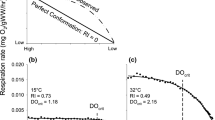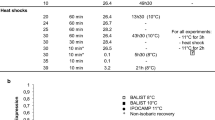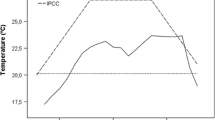Abstract
The upper temperature tolerance range for Trichomya hirsuta L. is described for acclimation temperatures of 10° to 32°C at 30% S. Changes in thermal resistance with time are described along with the incipient lethal temperatures. The eurythermicity for the species is 240.7 C°-squared. The ultimate upper incipient lethal temperature is 35.1°C. Definition of the incipient sublethal temperature is given, and is equal to 32°C. Diet effects are shown not to be significant in short-term lethal experiments, but indicate that unfed mussels reduce their resistance after prolonged exposure to high temperatures. Size was also shown to have no effect on resistance and tolerance. A comparison of the tolerance triangle of T. hirsuta with those of the temperate species Mytilus edulis and Mya arenaria revealed that the 24-h LT50 minus 2.2 C° approximates the incipient lethal temperature. The eurythermicities of the temperate species are Mytilus edulis, 363 C°-squared; and Mya arenaria, 415 C°-squared.
Similar content being viewed by others
Literature Cited
Anonymous: The heated effluent study for Victorian coastal waters. In: The Heated Effluent Study Technical Group Report, Melbourne, Australia: State Electricity Commission of Victoria, 1973. (Internal report)
Bayliss, D.E.: Marine fouling organisms in Lake Macquarie and Tuggerah Lakes, N.S.W., 177 pp. MSc. thesis, University of New South Wales 1973
Brett, J.R.: Temperature tolerance in young Pacific salmon G. oncorhynchus. J. Fish. Res. Bd Can. 9, 265–323 (1952)
Dickie, L.M.: Effects of high temperature on the survival of the giant scallop. J. Fish. Res. Bd Can. 15, 1189–1211 (1958)
Fry, F.E.J., J.R. Brett and G.H. Clawson: Lethal limits of temperature for goldfish. Revue can. Biol. 1, 50–56 (1942)
—, J.S. Hart and K.F. Walker: Lethal temperature relations of young speckled trout. Univ. Toronto Stud. biol. Ser. 54, 1–47 (1946)
Hum, J.: Distribution of Mytilus in Eastern Australia and New Zealand, 174 pp. MSc. thesis; University of New South Wales 1971
Kennedy, V.S. and J.A. Mihursky: Upper temperature tolerance of some estuarine bivalves. Chesapeake Sci. 12, 193–204 (1971)
Laseron, C.F.: New South Wales mussels. A. taxonomic review of the Family Mytilidae from the Peronian Zoogeographical Province. Aust. Zool. 12, 263–283 (1956)
Licchfield, J.T. and F. Wilcoxon: A simplified method for evaluating dose-effect experiments. J. Pharmac. exp. Ther. 2, 99–113 (1949)
MacIntyre, R.J.: Some aspects of the ecology of Lake Macquarie, N.S.W. with regard to an alleged depletion of fish. VII. The benthic macrofauna. Aust. J. mar. Freshwat. Res. 10, 341–353 (1959)
McErlean, A.J., J.A. Mihursky and H.J. Brinkley: Determination of upper temperature tolerance triangles for aquatic organisms. Chesapeake Sci. 10, 293–296 (1969)
Miller, D.C. and A.D. Beck: Development and application of criteria for marine cooling waters. In: Symposium on physical and biological effects on the environment, of cooling systems and thermal discharge at nuclear power stations. Oslo, Norway, August 26–30. Narragansett, Rhode Island, USA: Environment Protection Agency, National Marine Water Quality Laboratory 1974
Pearce, J.B.: Thermal addition and the benthos of Cape Cod Canal. Chesapeake Sci. 10, 227–233 (1969)
Powis, J.B.: The effect of power station discharges upon benthic infauna, 59 pp. Honours thesis, University of New South Wales 1973
Powles, P.M.: Lethal effects of hot water. In: Thermofluids Conference, Sydney. Thermal discharge engineering and ecology, pp 52–59. Sydney, Australia: The Institution of Engineers 1972
—: Survival of Australian anchovy Engraulis australis eggs and larvae in a heart trap. In: The early life history of fish, pp 373–381. Ed. by J.H.S. Blaxter. Heidelberg: Springer-Verlag 1974
Wallis, R.L.: Aspects of the thermal tolerance of Mytilus edulis L. Honours thesis, 88 pp. University of New South Wales 1973
—: Thermal tolerance of Mytilus edulis of Eastern Australia. Mar. Biol. 30, 183–191 (1975a)
Wallis, R.L.: Thermal resistance data for Trichomys hirsuta L. In: Ecology of selected estuarine organisms, Data List No. 4. School of Zoology, University of New South Wales: University Press 1975b
Waritswat, A.: Seasonal abundance, mortality and thermal tolerance of some plankton in cooling water of the three power stations at Lake Macquarie and Lake Munmorah, 223 pp. MSc. thesis, University of New South Wales 1975
Waugh, D.L.: Thermal resistance in relation to vertical zonation in three intertidal bivalve molluscs, Ph.D. thesis, Dalhousie University 1974
Author information
Authors and Affiliations
Additional information
Communicated by G.F. Humphrey, Sydney
Rights and permissions
About this article
Cite this article
Wallis, R.L. Some aspects of the thermal tolerance of Trichomya hirsuta (Mollusca: Bivalvia) of Eastern Australia. Mar. Biol. 43, 217–223 (1977). https://doi.org/10.1007/BF00402314
Accepted:
Issue Date:
DOI: https://doi.org/10.1007/BF00402314




